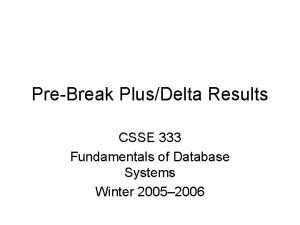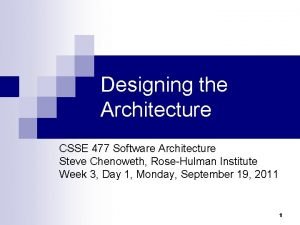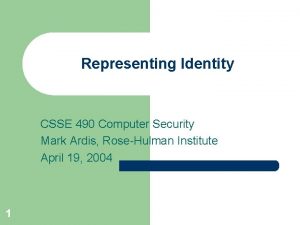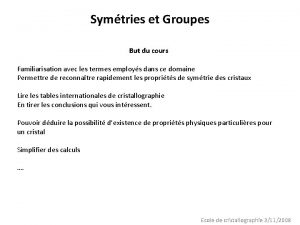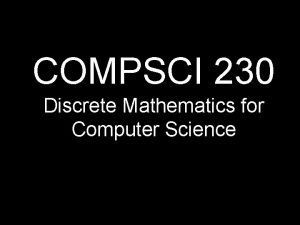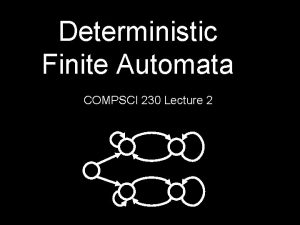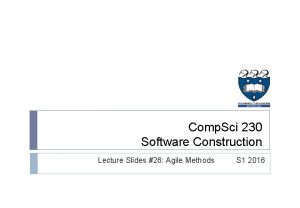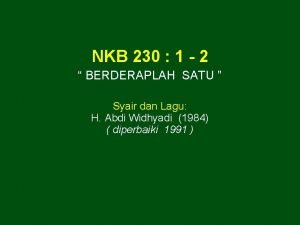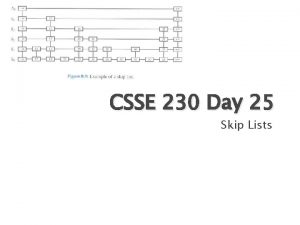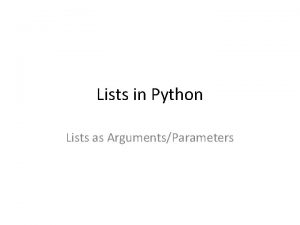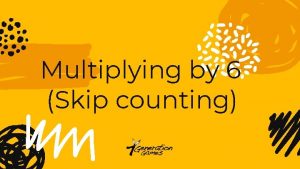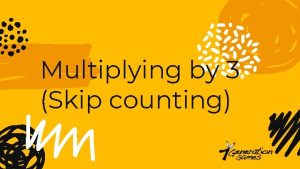CSSE 230 Day 25 Skip Lists RemindersAnnouncements Skip

























- Slides: 25

CSSE 230 Day 25 Skip Lists

Reminders/Announcements

Skip Lists An alternative to balanced trees Sorted data. Random. Expected times are O(log n).

An alternative to balanced trees � Indexed ◦ ◦ lists One-level index. 2 nd-level index. 3 rd-level index log-n-level index. Remember the problem with keeping trees completely balanced”? � Problem: insertion and deletion. � Solution: Randomized node height: Skip lists. ◦ Pugh, 1990 CACM. � https: //people. ok. ubc. ca/ylucet/DS/Skip. List. html Note that we can iterate through the list easily and in increasing order, like a threaded BST”

A slightly different skip list representation � Uses a bit more space, makes the code simpler. � Michael Goodrich and Roberto Tamassia.

Methods in Skip. List. Node class

Search algorithm

Insertion diagram

Insertion algorithm

Remove algorithm

(sort of) Analysis of Skip Lists � No guarantees that we won't get O(N) behavior. ◦ The interaction of the random number generator and the order in which things are inserted/deleted could lead to a long chain of nodes with the same height. ◦ But this is very unlikely. ◦ Expected time for search, insert, and remove are O(log n).

Questions

Exhaustive Search and Backtracking A taste of artificial intelligence

� Given: a large set of possible solutions to a Exhaustive search problem The “search space” � Goal: Find all solutions (or an optimal solution) from that set � Questions we ask: ◦ How do we represent the possible solutions? ◦ How do we organize the search? ◦ Can we avoid checking some obvious nonsolutions? � Examples: Mazes http: //www. numeracysoftware. com/maze 4. bmp The “ 15” puzzle

In backtracking, we always try to extend a partial solution dead end ? dead end start ? ? ? http: //www. cis. upenn. ed u/~matuszek/cit 5942004/Lectures/38 backtracking. ppt dead end ? success! Note: the search is a tree and we explore it using a pre-order traversal

In backtracking, we always try to extend a partial solution

The non-attacking chess queens problem is a famous example ◦ In how many ways can N chess queens be placed on an Nx. N grid, so that none of the queens can attack any other queen? ◦ I. e. there are not two queens on the same row, same column, or same diagonal. � There is no "formula" for generating a solution. � The famous computer scientist Niklaus Wirth described his approach to the problem in 1971: Program Development by Stepwise Refinement http: //sunnyday. mit. edu/16. 355/wirthrefinement. html#3 http: //en. wikipedia. org/wiki/Queen_(chess)

With a partner, discuss "possible solution" search strategies � In how many ways can N chess queens be placed on an Nx. N grid, so that none of the queens can attack any other queen? ◦ I. e. no two queens on the same row, same column, or same diagonal. Two minutes No Peeking!

Search Space Possibilities 1/5 � Very naive approach. Perhaps stupid is a better word! There are N queens, N 2 squares. � For each queen, try every possible square, allowing the possibility of multiple queens in the same square. ◦ Represent each potential solution as an N-item array of pairs of integers (a row and a column for each queen). ◦ Generate all such arrays (you should be able to write code that would do this) and check to see which ones are solutions. ◦ Number of possibilities to try in the Nx. N case: ◦ Specific number for N=8: 281, 474, 976, 710, 656 1

Search Space Possibilities 2/5 Slight improvement. There are N queens, N 2 squares. For each queen, try every possible square, notice that we can't have multiple queens on the same square. ◦ Represent each potential solution as an N-item array of pairs of integers (a row and a column for each queen). ◦ Generate all such arrays and check to see which ones are solutions. ◦ Number of possibilities to try in Nx. N case: ◦ Specific number for N=8: 178, 462, 987, 637, 760 (vs. 281, 474, 976, 710, 656)

Search Space Possibilities 3/5 � � Slightly better approach. There are N queens, N columns. If two queens are in the same column, they will attack each other. Thus there must be exactly one queen per column. Represent a potential solution as an N-item array of integers. ◦ Each array position represents the queen in one column. ◦ The number stored in an array position represents the row of that column's queen. ◦ Show array for 4 x 4 solution. �Generate all such arrays and check to see which ones are solutions. �Number of possibilities to try in Nx. N case: �Specific number for N=8: 16, 777, 216

Search Space Possibilities 4/5 � Still better approach There must also be exactly one queen per row. � Represent the data just as before, but notice that the data in the array is a set! ◦ Generate each of these and check to see which ones are solutions. ◦ How to generate? A good thing to think about. ◦ Number of possibilities to try in Nx. N case: ◦ Specific number for N=8: 40, 320

Search Space Possibilities 5/5 � Backtracking solution � Instead of generating all permutations of N queens and checking to see if each is a solution, we generate "partial placements" by placing one queen at a time on the board � Once we have successfully placed k<N queens, we try to extend the partial solution by placing a queen in the next column. � When we extend to N queens, we have a solution.

Experimenting with 8 x 8 Case � Play the game: ◦ http: //homepage. tinet. ie/~pdpals/8 queens. htm � See the solutions: ◦ http: //www. dcs. ed. ac. uk/home/mlj/demos/queens (if you can figure out how to enable Java in your browser)

Program output: >java Real. Queen 5 SOLUTION: 1 3 5 2 SOLUTION: 1 4 2 5 SOLUTION: 2 4 1 3 SOLUTION: 2 5 3 1 SOLUTION: 3 1 4 2 SOLUTION: 3 5 2 4 SOLUTION: 4 1 3 5 SOLUTION: 4 2 5 3 SOLUTION: 5 2 4 1 SOLUTION: 5 3 1 4 4 3 5 4 5 1 2 1 3 2 Tommorrow: We'll look at details of the algorithm. Bring your computer, capabl; e of compiling and running Java programs.
 Day 1 day 2 day 3 day 4
Day 1 day 2 day 3 day 4 Csse exam
Csse exam Csse results
Csse results Software architecture cartoon
Software architecture cartoon Mark ardis
Mark ardis Skip pointer information retrieval
Skip pointer information retrieval Day 1 day 2 day 817
Day 1 day 2 day 817 Msb 230
Msb 230 S230 crew boss test answers
S230 crew boss test answers Compsci 230
Compsci 230 Wpvr-230
Wpvr-230 2 cfr part 230
2 cfr part 230 Os 230
Os 230 Kvalitativa variabler
Kvalitativa variabler Section 230-240 of companies act 2013
Section 230-240 of companies act 2013 Duke cs 230
Duke cs 230 Représentation des 230 groupes d'espace
Représentation des 230 groupes d'espace Hhhhhhht
Hhhhhhht Zodiac cadet fastroller
Zodiac cadet fastroller Vodafone infodok 230
Vodafone infodok 230 300 e yuvarlanan en küçük sayı
300 e yuvarlanan en küçük sayı Compsci 230 duke
Compsci 230 duke Pengertian satuan sudut
Pengertian satuan sudut Système cristallin
Système cristallin Sci 230
Sci 230 Dkb 230
Dkb 230


